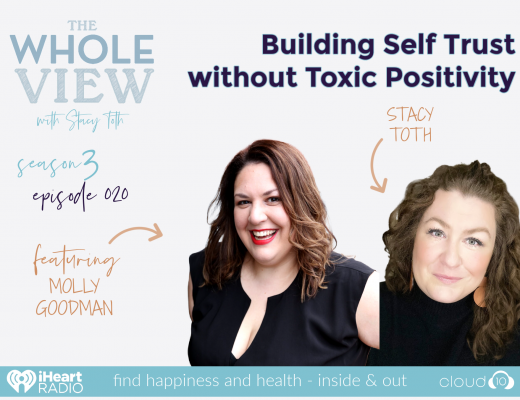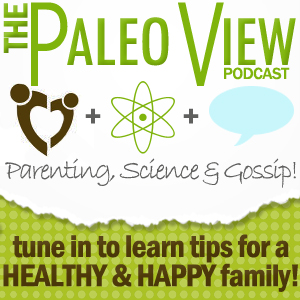 Welcome to episode 459 of The Whole View! This week, Sarah and Stacy share their best tips and tricks for gluten-free baking, sugar vs. sweeteners, and products recommendations they use and love!
Welcome to episode 459 of The Whole View! This week, Sarah and Stacy share their best tips and tricks for gluten-free baking, sugar vs. sweeteners, and products recommendations they use and love!
If you enjoy the show, please review it on iTunes!
The Whole View, Episode 459: Gluten-Free Baking, Our Best Tips and Tricks.
Welcome back to episode 459! (0:28)
Today, Sarah and Stacy will discuss baking and sharing their tips and recommendations for gluten-free baking.
They’ve received quite a number of questions regarding this topic.
Stacy recently revised a Lactation Cookie recipe from several years ago and realized just how much her mindset has changed since then.
Sarah and Stacy started from a one-sided Paleo approach but gradually moved toward a nutrivore, nutrient-dense mindset.
Sarah mentions she’s currently working on a new website dedicated to Nutrivore! So listeners should keep an eye out for updates.
It’s important to get away from this dogmatic approach to food to ensure you’re giving your body enough variation for it to heal.
Heritage Wheat for Gluten-Free Baking
Actually, the gluten content of heritage wheat is about the same as modern wheat, so from a celiac perspective, they’re both problematic. (13:30)
Stacy adds that gluten-sensitive vs. celiac is where you might notice a difference. As someone with Celiac Disease, even trace amounts of gluten will cause her issues.
It’s often thought that ancient wheat has less gluten, which is simply not true.
Estimates as much as 55% of the population have gluten sensitivity genes.
However, if you aren’t wheat or gluten-sensitive, ancient/heritage wheat is definitely a better choice than modern wheat.
Studies do show that ancient wheat has an overall anti-inflammatory profile, whereas modern wheat has a pro-inflammatory profile.
Sarah recommends this great review article for more information.
Scientists have a hard time pinpointing exactly why. Still, it seems to be a collection of small nutritional differences, slightly more digestible gluten, slightly more polyphenols, more carotenoids (lutein), and a slightly better effect on the microbiome.
Benefits of Almond Flour
Sarah has had a pretty long journey with almond flour. She used to use it all the time, then not at all, and it eventually started to creep back in. (19:40)
There are definitely health benefits to an ounce or two of nuts per day, which translates to ⅓ to ⅔ cups.
Almond flour is one of the more nutrient-dense flour alternatives, meaning it has more essential nutrients per calorie. And, like we covered in episode 413, it’s good for the gut!
But, when we’re talking about a treat, we’re accepting that it’s not going to be super nutrient-dense, generally.
Sarah prefers the chemistry of cassava flour for most applications. But, she also still uses almond flour.
She adds she does have some other more obscure flours in her pantry but rarely uses them (plantain, tigernut, sunflower, coconut, sweet potato, chestnut).
Stacy makes it less about what the flour is but rather what will work better for what you’re making. Some flours are heavier or denser than others, so the nature of the flour means it sometimes won’t rise.
Stacy keeps tapioca, oats, arrowroot, and rice flours in her pantry as well.
Cassava Flour for Gluten-Free Baking
Cassava does contain some cyanogenic glycosides (other foods that do include almonds, apple seeds, stone fruit pits, bamboo, flaxseed, lima beans) (32:50)
You can find the Legit Mixes here.
The sweet cassava that is available as an imported vegetable in Western countries has only about a tenth of the cyanogenic glycosides of the bitter cassava grown in South America and Africa, which makes it pretty low on the cyanide scale to start with.
And the even better news is that these compounds can be completely removed with proper preparation, which the major manufacturers of cassava flour, like Otto’s do.
And, when cooking with whole cassava, you can too! That’s why my recipe for cassava fries includes a boiling step before roasting.
Gluten-Free Baking on AIP
For questions regarding AIP baking at altitudes, Sarah and Stacy recommend checking out Elana Amsterdam! (39:05)
She does live at altitude, and she has great information available. She also has MS, which is autoimmune, and she’s been doing grain-free recipe blogging for a very long time.
Jovial has an AIP cassava-based pasta that’s so good!
Typical AIP substitutions for eggs are gelatin eggs, apple sauce, canned pumpkin, tapioca starch, mashed root veggies (especially cassava and taro, thanks to the mucilage fiber they contain).
Sarah also recommends trying fresh, mashed cassava (tapioca) in your recipes.
Sugar on Paleo and AIP
Sugar is about dose rather than being on a yes list or no list. (45:45)
Table sugar (cane sugar or beet sugar) is predominantly sucrose, a disaccharide made of one glucose and one fructose molecule.
Sucrose is digested and absorbed quickly, and the glucose it contains has a rapid impact on blood sugar levels and insulin secretion. Consumption of glucose increases the production of oxygen radicals and markers of inflammation, even in healthy people.
However, it is exaggerated in people who are obese or have type 2 diabetes, high cholesterol, or metabolic syndrome.
High sugar consumption can also lead to nutrient deficiencies.
Sarah covers this in-depth in How Does Sugar Fit into a Healthy Diet and 5 Nutrients You’re Deficient In… If You Eat Too Much Sugar.
High fructose consumption (the other half of the sucrose molecule) has been linked to obesity, insulin resistance, hypertension, fatty liver disease, type 2 diabetes, cardiovascular disease, metabolic syndrome, and increased cancer risk.
In fact, the biological effects of too much fructose are likely the driving force behind the association between high sugar intake and chronic diseases.
This is particularly important because of the rise of high-fructose corn syrup and because many sweet treats marketed to diabetics use fructose-based sweeteners. These are additives like agave syrup. Just because they don’t cause a rise in blood sugars doesn’t mean they’re harmless!
In fact, the evidence points to fructose-based sweeteners being even worse:
- Is Fructose a Key Player in the Rise of Chronic Health Problems?
- Fructose and Vitamin D Deficiency: The Perfect Storm?
- Why is High Fructose Corn Syrup Bad For Us?
- Is It Paleo? Fructose and Fructose-Based Sweeteners (I’m looking at you, Agave!)
Natural Sugars
It’s important to note that there is evidence that fructose from whole fruits is not the same as fructose-based sweeteners.
One recent study compared the metabolic effects of consuming 100 grams of fructose from high-fructose corn syrup versus fresh fruit. While both showed some problematic effects, it was much worse in the HFCS group.
Studies also show that eating 300 grams of fruit daily (about 4 servings and up to about 45 grams of fructose) causes the biggest decrease in all-cause mortality (a general marker of health and longevity), so eating fruit is good!
One piece of good news is that we don’t need to count fresh fruit towards sugar intake. The cusp for the negative effects of high-sugar intake really is around 10% of total calories from added sugars.
So, we don’t have to give up all sweet foods to be healthy, but rather choose our sugars wisely and moderate our intake!
The most important sugars to limit are refined ones, which don’t offer any redeeming nutritional qualities. Find Sara’s lists here:
The sweet taste of sugar is highly addictive, so it can be tough to reduce our intake or give it up. Sarah and Stacy covered this more in episodes 323: Cheat or Treat, Let’s Talk Sweets! and 300: How Do You Handle Sugar and Salt Cravings?
Other Sweeteners
Sadly, we can’t cheat sweets! Sweet substances that are not sugars are called sweeteners. (58:40)
They are artificial or natural substances that taste sweet but don’t contain caloric sugar molecules like glucose and fructose.
You won’t be surprised to learn that the artificial sweetener aspartame causes even more health problems than sugar. But you might not know that other nonnutritive sweeteners like sorbitol, mannitol, xylitol, and erythritol cause gut dysbiosis and increased intestinal permeability.
Sarah and Stacy discuss this more in, Is It Paleo? Splenda, Erythritol, Stevia, and other low-calorie sweeteners and Episode 309: Aspartame Is Evil
Even the two “natural” sweeteners predominantly used in products marketed to health-conscious communities — stevia and monk fruit — are problematic.
Just because something is “natural” doesn’t mean you should eat it. There is a health trade-off to everything. And just because it won’t raise blood sugar levels in diabetics doesn’t mean it’s safe to eat in large quantities.
There are now high-quality studies proving that stevia is an endocrine disruptor and problematic for the gut microbiome. This applies to the stevia plant and whole leaf stevia, too!
And monk fruit extract isn’t even approved as a food additive due to toxicity concerns and is only approved for supplements. For more information on this, see The Trouble with Stevia and What’s the Next Superfood Sweetener?
Allulose is the molecular mirror image of fructose. While it hasn’t been extensively studied, it’s brought into the body by the same receptor (GLUT5). So we know that it can biologically behave similar to fructose, and we’d therefore expect similar problems.
What Do Sarah and Stacy Suggest?
Sarah thinks it’s important to focus on the best way to enjoy a sweet treat – real, natural sugars, in moderation. (1:10:20)
The best choices are unrefined sugars that offer some nutritional value, like unrefined organic cane sugar, molasses, maple syrup, and honey.
Blackstrap molasses is so nutrient-dense that it contains 1.5 times more calcium per calorie than cheese and 5 times more iron per calorie than steak!
Plus, it’s rich in copper, selenium, manganese, magnesium, potassium, and vitamins B2, B3, and B6. Just one tablespoon contains 20% of the DV of calcium, iron, copper, and manganese, for only 42 calories.
Honey
Honey has known antioxidant and antimicrobial properties and may promote tissue health.
Even though it’s natural sugar, there’s evidence that honey can help regulate blood sugar levels in diabetics and improve the efficacy of metformin!
It’s also been shown to be therapeutic in both chronic constipation and chronic diarrhea because it acts as a selective prebiotic for Lactobacillus and Bifidobacterium. It also inhibits the growth of undesirable microorganisms that can act as pathogens.
There’s even some evidence showing that eating honey can reduce cardiovascular disease risk factors and cancer risk.
Plus, honey contains calcium, potassium, magnesium, phosphorus, selenium, copper, iron, manganese, chromium, zinc, and vitamins B1, B2, B3, B5, B6, B9, C, and K. When we examine all of the health problems associated with high-sugar intake, honey seems to reduce risk.
All this to say that there really isn’t a way to cheat sweet, but we also don’t need to if we’re conscientious about how often and how much sweet treats we’re indulging in.
Natural sugars in moderation absolutely can fit into a healthy diet.
Final Thoughts
Stacy and Sarah are not here to demonize the choices you make and why you make them. They want to empower you to make those decisions for yourself and not be influenced by this idea of being afraid. (1:21:45)
You can never give up everything in life. It’s about making things sustainable for you and giving you the knowledge to make informed health decisions to help you live your life to the fullest.
Stacy encourages listeners to have freedom from the pressure and dogma that the entire culture has created around being afraid of certain foods.
Sarah adds that we need to be aware of how these marketing campaigns aren’t only about buying that product but make you feel bad about your alternate choice. And it’s not always grounded in scientific evidence.
You can join Sarah and Stacy over on Patreon for their unfiltered thoughts on this episode. If you’ve not joined the Patreon family yet, joining gets you access to bonus content and is first in line with any questions.
Thanks for listening, and we will see you next week!

Want more info on our Real Life? Never miss a post with our Real Everything newsletter (and get our best selling book, Eat Like a Dinosaur, as a welcome gift). Join here
Wanna be Healthy Inside & Out? Get educational info and exclusive sales with our non-toxic living newsletter (and get free samples as a thank you for joining our safer skincare community). Join here




